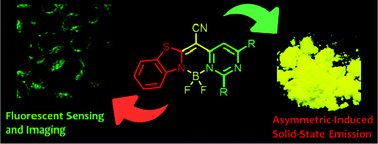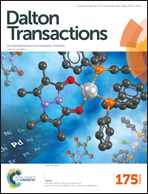Benzothiazole–pyrimidine-based BODIPY analogues: promising luminophores with fluorescence sensing and imaging ability and asymmetrization-induced solid-state emission†
Abstract
A new family of BODIPY analogues (BDB1–8) derived from benzothiazole–pyrimidine-based bidentate ligands was synthesized and fully characterized. The photophysical properties of these boron complexes were measured both in solution and solid-state. These new luminophores exhibited intense fluorescence with high quantum yields ranging from 0.27 to 0.79, and moderate Stokes shifts ranging from 660 to 2120 cm−1 in solution. Due to the existence of strong intermolecular interactions, BDB1–8 showed quenched fluorescence with low quantum yields ranging from 0.03 to 0.20 in solid-state. In addition, BDB1 and BDB2 were capable of sensing cysteine in aqueous solution with high selectivity and sensitivity, which means that these complexes hold great potential in serving as fluorogenic cysteine sensors for biological application.



 Please wait while we load your content...
Please wait while we load your content...